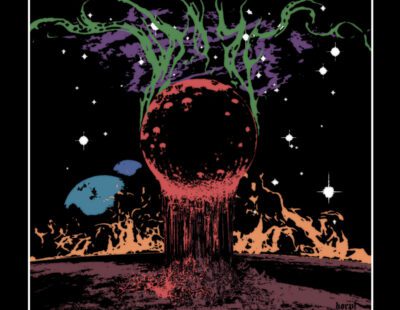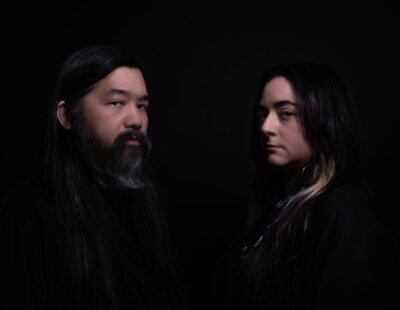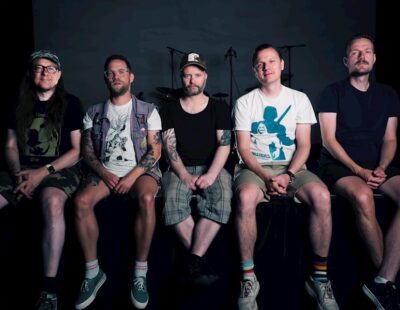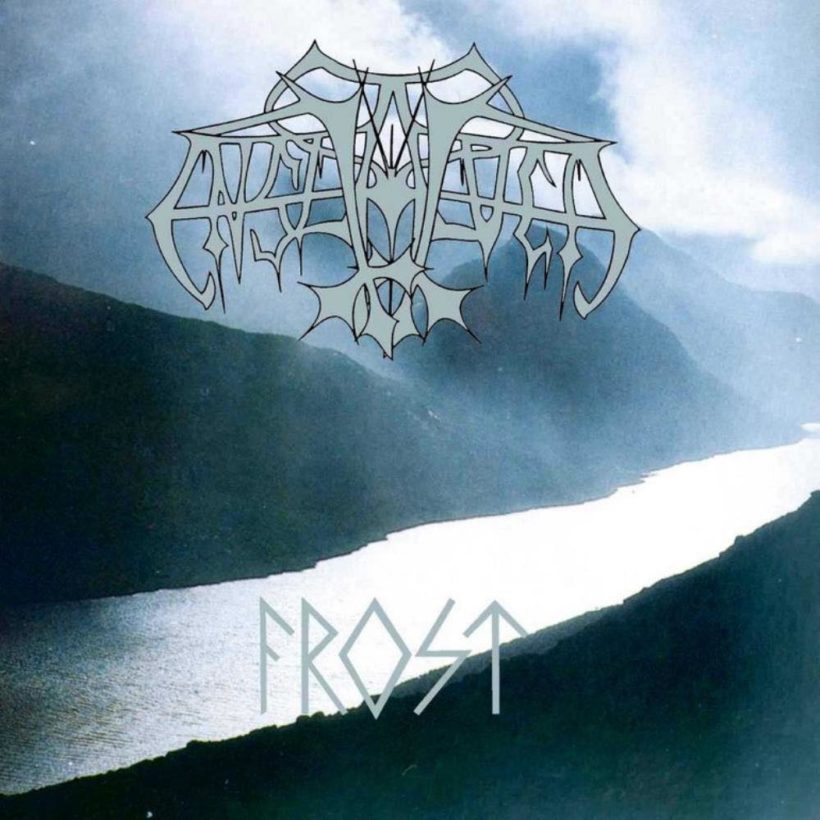
Enslaved‘s Frostcelebrates its 25th year in existence this year and attendees at Decibel Metal & Beer Fest: Philly will be treated to an exclusive, full performance of the Decibel Hall of Fame-inducted album on Sunday, April 14. While we impatiently wait for that day to arrive, you can read Decibel’s complete Hall of Fame induction (previously sold out in print), featuring interviews with each member—Ivar Bjørnson, Grutle Kjellson, Trym Torson—who performed on Frost. If you don’t have tickets for Decibel Metal & Beer Fest: Philly, get them here.
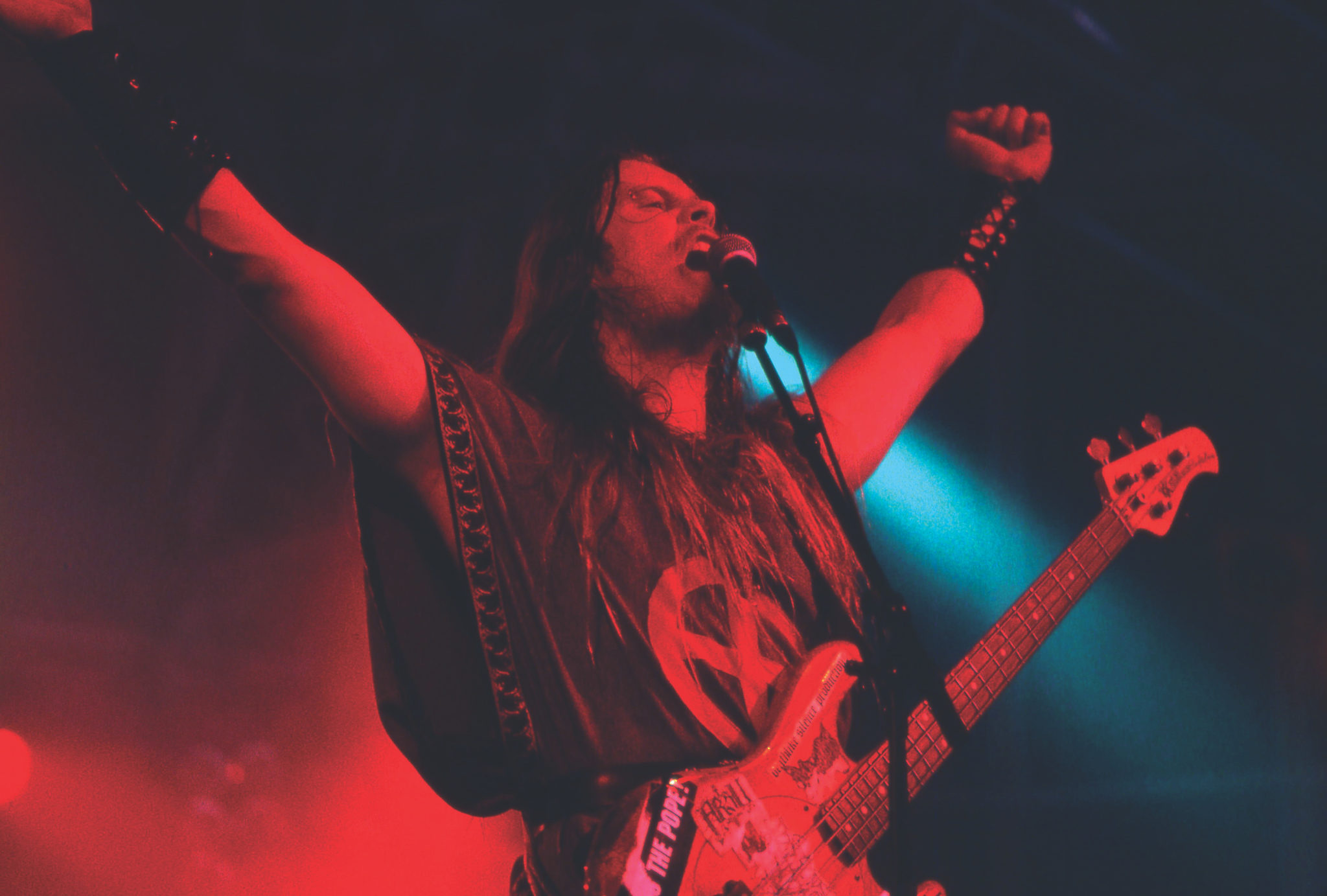
If black metal was defined by a single year, it would have to be 1994. Not a single calendar year before or after could possibly compete with—in sound, vision and diversity—De Mysteriis Dom Sathanas, In the Nightside Eclipse, Hvis Lyset Tar Oss, Suomi Finland Perkele, The Shadowthrone, Bergtatt, Transilvanian Hunger and Opus Nocturne. Though the second wave of black metal had crashed a few years before, the biggest wave was in 1994. And with it, the second wave of Viking metal.
The first Viking metal wave was nothing like the second, however. The unifying bonds—cultural history, geographic location, a connected (via post offices worldwide) underground network—just weren’t there. Nevertheless, proto-Viking metal was. As early as the late ’70s, in fact. Faithful Breath could be viewed as the genesis, replete with fur and horned helmet costumes and epic album art (check out Back on My Hill). They weren’t the only ones either. Sweden’s Heavy Load purloined Nordic myths and imagery in the early ’80s. As did Norwegians TNT, for one album. But the true innovator was Bathory. Over three albums—Blood Fire Death, Hammerheart and Twilight of the Gods—the Quorthon-fronted outfit braved it all to create the first-ever cohesive metallic tribute to the Vikings.
So influential and symbolically important were these records that they inspired three Norwegian teenagers, one as young as 13, to form Enslaved in 1991. Though the trio’s first foray into Viking metal was enough to ink a deal with then-cult label Deathlike Silence Productions, it’d take an EP, Hordanes Land, and a debut album, Vikingligr Veldi, for Enslaved to find a (left hand) path of their own. Enslaved had arguably fara I Viking-ed on Hordanes Land, but internally they—particularly guitarist Ivar Bjørnson and frontman/bassist Grutle Kjellson—knew songs about battles, desolate snow-capped mountains and fjords could only go so far. This was stuff for neophytes and surface-dwellers, not a group of intellectually- and culturally-motivated teens.
Enslaved’s fingerprint—Bjørnson’s quirky chords and berserk arrangements, Kjellson’s battle-worn caterwaul and Trym Torson’s deft blasting—remained intact on second album Frost, but for all intents and purposes, this album marked the beginning of a long sonic and philosophic sojourn. First and foremost, Bjørnson dialed back on Vikingligr Veldi’s theme repetition. Gone were the endless riff cycles of “Midgards Eldar” and “Lifandi Liv Undir Hamri.” And Kjellson dove headfirst into Norse myth. He was less concerned about the retelling of Thor’s fateful encounter with the Midgard Serpent than the root of the conflict. Kjellson knew it was time to reclaim the gods and goddesses of his ancestors, especially if it meant his version of things would inevitably clash with the Christianized fairytales so often associated with Nordic myth. And, finally, Enslaved—out of respect for and to differentiate themselves from a burgeoning black metal scene—had branded the term Viking metal on Frost. Officially.
Decibel is hereby honored to induct our first (and possibly last) Viking metal record, Enslaved’s Frost, into the Hall of Fame. As stated in one translation of a Hávamál passage: “Cattle die / and kinsmen die / And so one dies one’s self / But a noble name / will never die / If good renown one gets.” See you in Valhalla, guys!
1994 was the year of Enslaved. You guys had proverbially landed on the extreme music scene with not one, but two albums.
Ivar Bjørnson: Absolutely. It was a year when it all sort of began for us in a bigger context. We started to think of ourselves as a band with a future. We saw it in terms of years and thinking ahead. Before that, we didn’t have any perspective. We did the mini LP [Hordanes Land] and Vikingligr Veldi. The feedback internationally for Frost was really good. People started to talk about touring. We started to see that we were about to achieve exactly what we wanted with the band. Quicker than we expected, really. We felt the band was going the right way. Every phone call we got was a big leap for the band.
Do you have specific memories around the writing and recording of Frost?
Bjørnson: A bunch of good memories. It’s been like something like 15 years ago now. We recorded in Bergen, but at the time we were living in Haugesund, our native hometown, which is like three or four hours south of Bergen. Bergen was the epicenter for metal in our part of the country. That’s also where Grieghallen [studios] was. We borrowed an apartment from my dad’s girlfriend’s son. At the time he was studying in Bergen, but this was summer, so he wasn’t there. Yeah, good times. [Laughs]
Trym Torson: For us, it was always doing what we wanted to do. Being a part of the black metal scene, even though we weren’t black metal. We didn’t look at it as a big thing. There were maybe 20 people that were exchanging ideas about music. From the beginning, we didn’t want to have black metal lyrics, but it had to be as Norwegian as possible. We even sang in Old Norwegian and Icelandic. I don’t remember being hassled for going our own way. On the contrary, people were into what we were doing.
Was Enslaved a group effort? I know Ivar wrote most of the music.
Bjørnson: We were a little gang. It’s the same now. I write all of the music. Me and Grutle would share lyrical duties. On Frost, I think I wrote two of the lyrics. Socially, we were two small groups within the group. Trym and Grutle never really spent time together. Just the two of them. They would mostly socialize within the context of the group. Trym is my really old friend from the little town where I grew up. He had relatives there. He was an older guy who was into metal, so I was instantly interested in getting to know him. There was nobody else around that was into metal. When we split up Phobia and started Enslaved in ’91, I remember Trym as a guy who played drums. By that time, me and Grutle had become friends. So, it was me and Grutle, me and Trym or the three of us together. It was mostly about me and Grutle, putting our heads together to come up with conceptual ideas, by the time Frost came around.
Grutle Kjellson: Frost was one of the first albums I wrote most of lyrics for. It was the first time we went deeper into the mythology. More like trying to find the philosophical background to the myths. Something else than bedtime stories the Christians wanted us to believe for the past 1,000 years. Dig beyond the layers of Christian deception and lies, so to speak. Frost was the first album we tried to do that. To interpret the myths ourselves. To make them our own.
Torson: Ivar would write the riffs. Then we’d get together and practice the riffs. If I had some ideas, we’d work on changing his riffs. Also, if he had some ideas on drums, we’d work those out. I remember Grutle was working, so we really only had the chance to practice as a group on the weekends. That’s when we shared ideas as a group.
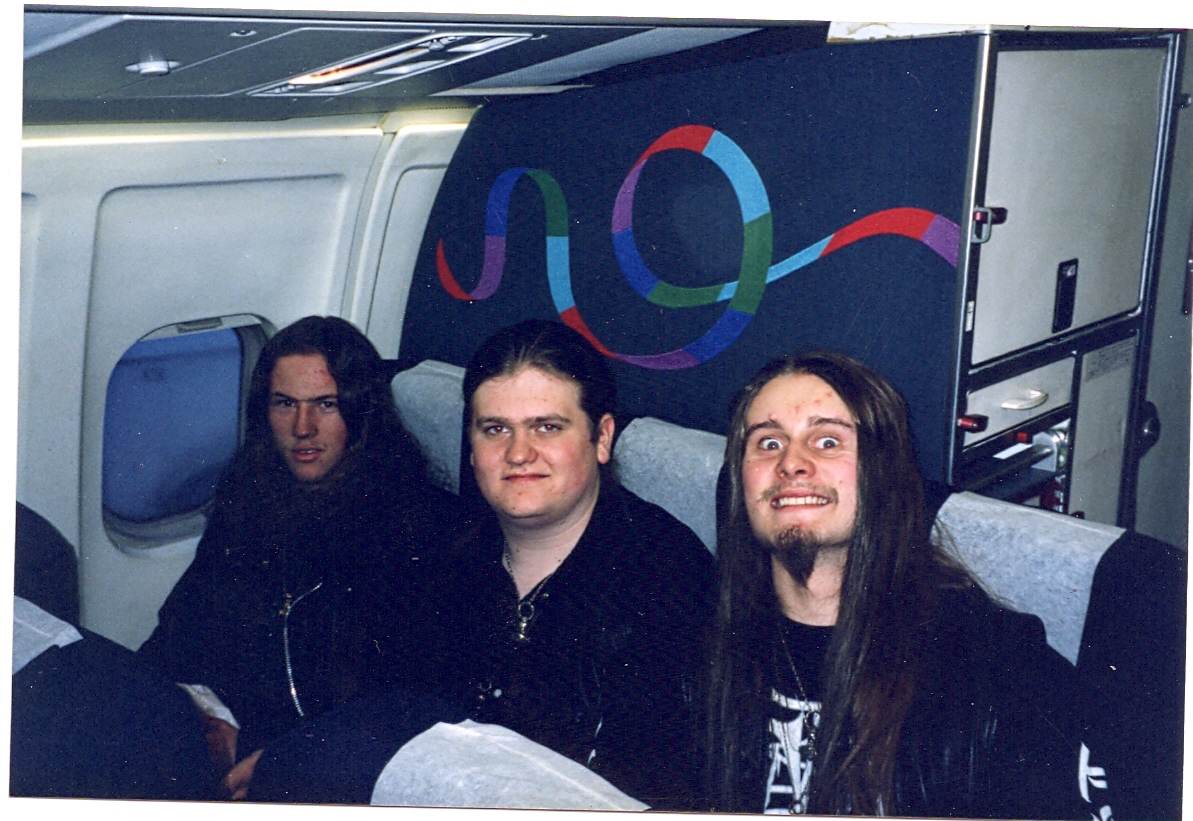
Did your families support Enslaved?
Bjørnson: My dad and Grutle’s mom were really supportive. From the very first days of the band. They were both teachers, so they had experience in feeling out what is a healthy interest and what is not. Now, when my dad comes backstage after shows, he’ll have a beer and brag about how he was listening to the black metal of the day back in the ’60s. Before anyone else had heard about the Rolling Stones. Stuff like that. I think he recognized that when you become dedicated to a musical movement, it’s important. My dad and Grutle’s mom were really helpful in talking to other parents, too. Making them realize it’s a genuine art form. We weren’t about opposing parents or anything like that. We didn’t relate Enslaved to opposing anything. Frost was a pro thing. Not an anti.
Kjellson: My mother paid for the printing of the first 100 Enslaved T-shirts back in ’92. My mother and Ivar’s father were the biggest money sponsors for the band.
Torson: Oh yeah! My mother bought me my first drum kit. I was around 14 years old. I had always wanted to have a drum kit, but I never knew how to play drums. I was utterly confused. I couldn’t even play a beat. I just pounded on the toms. [Laughs]
You were teenagers when Frost came out. How much of Enslaved circa ’94 was the product of the band searching for an identity or a voice?
Bjørnson: I think we had a pretty good idea of what we wanted to do in Enslaved. We came from Phobia, a death metal band. We did that in ’89. We had a demo. We did gigs outside Bergen. The band was getting a bit of a name in the Norwegian underground. The reason why we split up Phobia is because me and Grutle realized we were playing music that we wanted to play—it was brutal and all that, but it didn’t really mean anything. We got that feeling it was just five guys who got together after school to jam. That wasn’t exactly what we were looking for. Also, at the same time you had Darkthrone, Mayhem and all those guys breaking black metal to the moon and beyond. It was a big inspiration to us. Not the whole Satanic thing, but the whole other thing: layout, lyrics, image, song titles, even fonts on the album covers. Everything was part of a big whole. That appealed to us. Some of the guys took it to the extreme, which was a reaction to the American and English bands—dudes in Bermuda shorts. Back then, it felt like black metal was serious. Like it was trying to relay something important.
Every song, save “Svarte Vidder” and “Isöders Dronning,” was written in ’94. Were they leftover songs from the Vikingligr Veldi sessions?
Bjørnson: They were written after the Vikingligr Veldi sessions were closed off. The timing around Vikingligr Veldi and Frost was a bit weird because of the whole Deathlike Silence thing. Vikingligr Veldi was a year delayed, so that’s why it’s so close to Frost. The recording of Vikingligr Veldi was finished during the summer of ’93, if I remember correctly. We started writing for Frost in the autumn and winter of ’93.
Kjellson: “Svarte Vidder” was written in early ’92. I’m not too sure why we didn’t include that song on Vikingligr Veldi instead. It would’ve been suitable more for Vikingligr Veldi than Frost. “Isöders Dronning” was the last song we wrote for Frost. We have always had the tendency for the last song we write to be an indicator of how the next album is going to sound. “Isöders Dronning” is the song on Frost that most reminds you most of [1997’s] Eld. It’s always been like that, unfortunately. [Laughs]
What did the rest of the guys think of the Frost material the first time you played it for them, Ivar?
Bjørnson: Nothing special, if I remember correctly. We were into rehearsing a lot, dedicating our time to the music. Every time I would show up with a new song, the guys would immediately dig their fangs into it and add their own expressions to it. It was different from Vikingligr Veldi. On that album, it was more about repeat[ing] things. I think 48 is the record on that album. They’d say, “OK, how many times do we play this riff?” I’d say, “Um, 48.” They’d reply, “Seriously?” [Laughs] I do think Frost was something the guys really liked—the direction we were heading in.
There weren’t too many solos on Frost. Why is that?
Bjørnson: Personality-wise, I’m an Yngwie Malmsteen kind of guy. With the big hairdos. Fast cars. Stuff like that. Technically speaking, I had already developed or found my guitar voice. I’m more or less self-taught. I inherited—from my dad—a bunch of guitar lesson books from the ’60s and ’70s. They were about chords, ranging from easy Bob Dylan protest songs to complex Simon & Garfunkel songs. A lot of kids were fans of the shredders. I guess it was too late for me by the time I was aware of the shredding tradition. I had settled as a rhythm guitarist. I was into guys like David Gilmour, Euronymous from Mayhem, Snorre [Ruch] from Thorns. It wasn’t until Roy [Kronheim, guitars] was in the band that I started to think about leads. It was a gradual discovery.
Progressive rock influences started to come through on Frost. That’s how I hear it, at least.
Kjellson: Well, you can hear the progressive influences coming through on “Isöders Dronning” and “Fenris.” Those songs were like something is yet to come.
Bjørnson: Absolutely! All that stuff happened naturally. We were listening to things like Klaus Schulze and Tangerine Dream. Also, Rush and Yes. Stuff everybody’s heard. We were inspired by the way they used the keyboards. The way they wrote songs.
The productions of Vikingligr Veldi and Frost vary drastically. I’ve always felt Frost was a bit on the thin side. I guess it’s not as layered as Vikingligr Veldi.
Bjørnson: Yeah, Frost is more personal. I couldn’t tell you how we did the guitars on Vikingligr Veldi. The focus wasn’t on the guitars. It was more about getting the right amps into the studio and finding a sound. With Frost, we had our own ideas. Like for the guitars. I used the Swedish death metal sound for the guitars. Half of the sound is from a bass amplifier with a really heavy distortion pedal plugged into it. The other half is the traditional set-up. My own sound. Frost is more of a band sound, whereas Vikingligr Veldi is more layered. Frost is more direct. It’s the sound of a trio.
Kjellson: Frost was recorded on a different drum kit and with a different drum production. It was the first time we used triggers on the bass drums. I still have nightmares about that. Tick-tock, tick-tock. It was extremely annoying listening to the drums being triggered. I couldn’t believe my ears! So, the drums sound a bit different. It’s more in your face and in the forefront.
What was it like working with Eirik “Pytten” Hundvin on Frost?
Bjørnson: It was great. We had already worked with him on Vikingligr Veldi. He had a reputation. He was an open-minded and cool guy. He was the first guy outside the extreme metal scene to become a major player. The first thing he did was Old Funeral. Immediately when Pytten heard this new direction—he didn’t really care for heavy metal—he thought there might be hope for kids after all. He was enthusiastic. When bands went in to record with him, they’d call all their friends and say, “You have to record with this guy!” He would do a lot of hardcore pro bono work. You’d show Pytten your contract, show him the amount of money you had to work with and he’d make it happen. I remember he was always trying to be positive. He’s an old teacher, so he’s always trying to be fair and democratic. He just loved Trym’s drumming. He said, “You’re such an amazing drummer. I can’t believe the energy you have.” Then he looked at me and said, “Those arrangements are beautiful.” He had a worried look on his face because he saw that Grutle was in the room and said, “You make the best coffee.” [Laughs] He’s still very active as a concert producer in Bergen.
Kjellson: We only had a couple of fights. A couple of times I told him to go kill himself. Apart from that, things went excellently. [Laughs] He wanted me to do the laughter at the end of “Loke” all over again. I was tapping on my belt. He said he could hear it. “Oh, I can hear it!” he claimed. It was at the end of a really long day. I said, “I can’t hear it. You can’t hear it. Maybe you can hear it, but you’re just saying that to annoy me!” I remember telling him, “I won’t do it again. You know that. It’s perfect. You can’t hear the fucking belt tapping.” He just said, “OK, pack your gear and get out of here!” I said, “Fuck you! You’re going to use this! We’re paying you!” It was a stupid fight. In the end, we kept the recording and laughed about it the next day. The belt tapping is there, I guess.
Your image differed from black metal. Ivar had the executioner’s outfit, Grutle was sporting the Viking helmet and Trym had the Spanish replica sword. Were you trying to figure out your image at the time?
Bjørnson: I don’t know where the whole mask thing came from. My idea of the executioner was perhaps inspired by Sodom. I think some people thought I was into S&M. I had an Irish lady calling me for a few years after Frost came out. I’d tell her to fuck off and she’d think that was part of the whole sadist routine. She’d hang up and call me the next day, ready for more abuse. Like, “Stop calling me, you fucking bozo!” [Laughs]
Kjellson: I wish I knew! [Laughs] I was basically dressing up like a Viking warrior king. I had no idea what the others were trying to do. Not even today. At least we didn’t have any horn helmets. It’s not heresy as long as there aren’t any horns. That’s the ultimate cartoon.
Torson: We wanted to project a Viking image. We didn’t want to look like a regular Viking. They were farmers. They were only Vikings when they traveled outside of Norway. I remember us looking at images from movies like Conan. Ivar found the executioner’s mask at a market. He thought it looked cool. I had this sword, but it wasn’t a Viking sword. Those were hard to get a hold of. I found it at a market. We used what we had. Sverd from Arcturus made his own chainmail, too. I had him make me a chainmail, so I used that. A lot of us had chainmail. [Laughs]
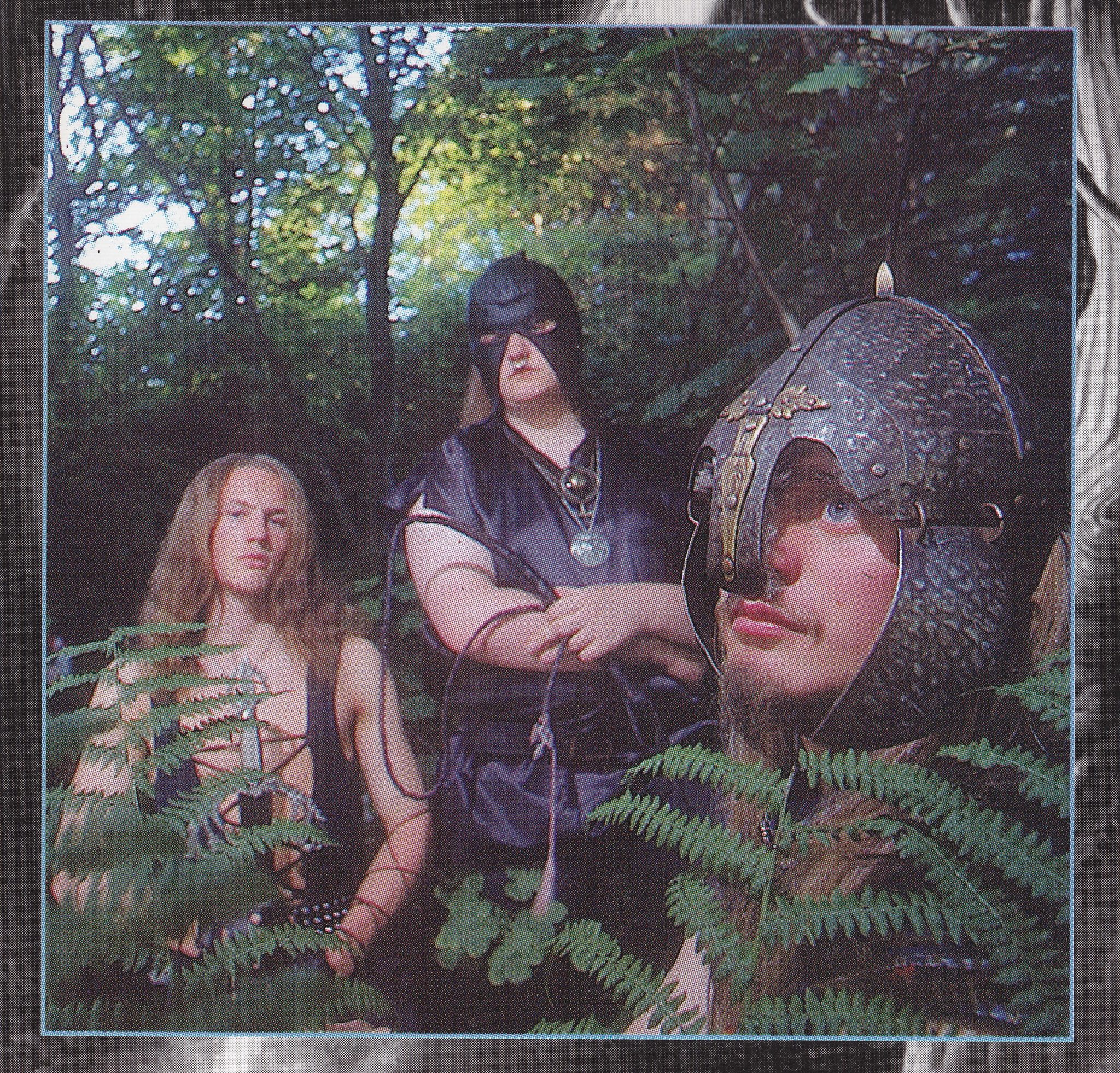
The term “Viking metal” was on the inside sleeve. Was that a declaration as to what style Enslaved played?
Kjellson: It was a declaration, or rather a statement, that we weren’t black metal. We didn’t have Satanic lyrics. We felt, “Oh, let’s call it Viking metal.” I know now we shouldn’t have done that. It started an avalanche of folk metal bands. Bands that sang about drinking beer and raping. We still got them today. Loads of them! Suddenly, Viking metal is a genre. Well, I’m not the only one to regret that now. [Laughs]
Can you tell me where you found the cover photo for Frost? It’s such a striking image.
Kjellson: We had the title Frost. We wanted the best frost imagery we could possibly find. We were in a bookstore in Bergen. It’s from a tourist book, actually. Something like Discover Norway. One of those books. It’s from an area called Jotunheimen in the middle of Norway. It’s a fresh water mountain lake. When we saw it, we were like, “Ah ha! This is absolutely perfect! This is our cover.” I think it’s better than Twilight of the Gods, to be honest.
Apart from Bathory’s Viking period, would you consider Enslaved the first of its kind?
Bjørnson: Yeah, when we started Enslaved we had to have a concept. Black metal wasn’t fitting for us. That’s out of respect for the black metal bands, too. Those early black metal bands had a strong feeling for what they were doing. They put a lot of meaning into it. Coming from families of teachers, both me and Grutle had a lot of books at home about the Vikings. At the same time, Bathory is a band I got into with the Hammerheart album. Hammerheart and Twilight of the Gods being my favorite Bathory albums, it just fit perfectly with Enslaved. We wanted a strong concept around the band, something that could fit both the aggressive and violent side and the mystical and beautiful side. The whole Northern theme.
Describe the Frost tours of Europe, the U.S. and Mexico.
Bjørnson: The first thing we did was the Winter War Tour in ’95 with Marduk co-headlining. It was the second time a Norwegian extreme metal band went out on tour. We had heard the stories from the Immortal guys who went out on tour with Rotting Christ the year before on the subtly named Fuck Christ Tour. Ours was the Winter War Tour. Not exactly Einstein material either. It wasn’t Fuck Christ, at least. [Laughs] It was crazy. At the same time, it was our first time outside Norway, so we were equally fascinated by the fact that we never ran out of beer and we didn’t have to pay for it. Which was quite an experience. The U.S. tour was great. We got in touch with John McEntee from Incantation. He made it all happen. It was us, Incantation, Absu and Kataklysm. I still feel bad for John. He had so much bad luck on that tour. It was insane. It’s unreal how much how many bad things happened to him during that tour.
Kjellson: The first European tour with Marduk was well-organized. We had a tour manager, equipment, a tour bus, a nice band to tour with, good venues, food and sleep. When we went over to the States, we were like, “Oh, man! This is going to be so cool!” In many ways it was cool, but we played a lot of real shitholes. The cars broke down. The AC wasn’t working. One of the cars broke down in Central Bronx. That was exciting. I remember that was John McEntee’s idea. “I wanna drive you around to the worst neighborhoods in New York.” It’s like, “OK, let’s go.” The car breaks down. He said, “Ah, I guess we’re a bit unlucky now. The car’s fucked.” So, yeah, thanks John! When the tour started going badly, he would always try to change the morale of the band. He’s like, “Hello, Grutle. Do you feel like rockin’?” “No, I don’t, John!” He then said, “Well, you look like a rocker to me!” [Laughs] That was pretty funny. After the U.S. and Canada, we went on to Mexico for 14 days. We got stopped a couple of times at checkpoints. We never had American money to give to the police, so we’d give them merch. Things took a hell of a long time. The last show of the tour was in Torreón. When we came to the venue, it was too late for the gig. They set up an emergency gig two days later with all the equipment they could get. I did the vocals and bass through a ghetto blaster. They managed to get two bass drums, but one of them was from a children’s drum kit. [Laughs] The guitar amplifier was a 20-watt Peavey. We sounded ridiculous. The backstage was inside a whorehouse. It was kind of special, to say the least.
Torson: The U.S. tour was a no-budget tour. We were traveling in a van without AC. It didn’t even have back seats. There was just a small two-seat couch in the back. We took turns sleeping on the couch. I remember being tired all the time on that tour. We didn’t really sleep. Even though there were bad conditions throughout the tour, we learned a lot. That tour, especially the Mexican part, changed us. The Mexican part was the worst. It was a real nightmare. I love Mexican food, but we ate from the street. Mexican hot dogs. I mean, when they say hot dogs, it was fuckin’ really a hot dog. Or maybe rat. I don’t know what those sausages were made of. Everybody got sick. I remember being pulled over by the police. It was in the middle of fucking nowhere. The road was gravel, no lights, nothing. They had machine guns; they took our passports and made us stand in a ditch. At that time, I was sure they were going to take the few dollars that we had, steal our stuff and shoot us while we stood in the ditch. I was like, “Oh, shit! I’m gonna die in Mexico.” I was so sure of it.
Trym left in ’95. What were the circumstances around his departure?
Torson: Me and Grutle were arguing a lot. Ivar’s the main guy. He writes all the music. Grutle’s the lyric guy. So, I think they thought it was easier to get rid of me than to get rid of one of them. Even though me and Ivar had more similar musical interests, it was easier for those two continue with a new drummer. I left and eventually joined Emperor. You can say I was pretty happy with the change. I remember getting the call from Samoth. He learned that I had left Enslaved. He was still in jail at the time. I was going to school and living in Stavanger, with the Gehenna guys. I was rehearsing with them a bit. Samoth asked if I wanted to try out. They had tried out a lot of drummers, like Hellhammer, Frost and Erik [Brødreskift]. I think the drummer from Ulver tried out, too. I had one practice and the rest is history.
Bjørnson: It was after we came home from the ’95 tours. It was really un-dramatic. We had done the European tour, which was really easy- going. It was like a party. We had our first experience with reality on the U.S. tour. There were some pretty low times on that tour. Like when we got dumped in Mexico by the promoter. He dumped us on the street, so we had to go 24 hours by bus—with a bunch of Mexicans and their chickens—to the border. We had to find our way back. There were some weird things going on with merch sales and money getting stolen. When we encountered those things and when we realized the social fabric wasn’t totally solid—I was the guy binding Trym and Grutle together in the band—is when we figured out it wasn’t going to be the three of us forever. Also, me and Grutle, during that tour, we started planning ahead. We were discussing musical influences. We discovered that we were talking a lot about progressive music and slowing down a little. Adding more melody. The gap widened when we realized Trym didn’t want to go in the same musical direction. Emperor was a perfect match for him.
Do you guys have a favorite song on Frost?
Bjørnson: It changes a lot. I’m fond of “Gylfaginning.” We really tried something with that song. It sounds very intense on the album. It’s a little above what we were capable of at the time. We almost pulled it off in a way that makes it sound on edge. I like “Fenris” a lot. It’s got a really strange song structure, if you can call it structure at all. [Laughs] It has a little funky middle section with the synths. That part was inspired by “Escape From the Island” by KISS off The Elder.
Kjellson: I like “Loke” a lot. I also like “Fenris.” The most suitable song for our new lineup is “Jotunblod.” I like the ideas—not the performance—on “Isöders Dronning” and “Gylfaginning.” The ideas are pretty cool. But I’d have to say “Jotunblod” is my favorite.
Torson: When you listen to songs and when you play songs they’re totally different. I like “Loke.” It has all the elements I like. But, to be honest, I don’t even remember all the songs on the album.
Vikingligr Veldi was a tribute to Øystein Aarseth. By the time you were writing Frost, were you still dealing with physical and psychological impacts of Aarseth’s death?
Bjørnson: Yeah, I guess so. It took a really long time for everybody that was close to it. When the trial was done, it put a really big lid on everything. I think it was regarded as a supernatural battle between good and evil. But it wasn’t, I think. The way things were portrayed by the media, it left a bad taste in our mouths. We also fell into the trap of leaving it [alone] for a long time.
Kjellson: No, I wouldn’t say that. I don’t think it affected my writing at all. We were split in two—those that followed Count Grishnackh and those that followed Euronymous. It actually happened twice. Things were starting to crystallize half a year before he died. Something bad was starting to happen. Everybody could basically feel it. Something wasn’t right. I remember Euronymous told me he visited an old psychic woman who had foreseen Count Grishnackh was going to kill someone. Euronymous said, “It will be really interesting to see how that turns out.” It turned out to be him. So, yeah, that was pretty crazy.
Torson: Yeah! The first album was supposed to be released on Deathlike Silence Productions. I remember I was at home watching the news. There was a murder in Oslo—black metallers. I was like, “What the fuck is this?!” When they said Øystein Aarseth, also known as Euronymous, had been killed, I couldn’t believe it. I was like, “No. No. This is impossible!” I called Ivar immediately. He was like, “What?!” We freaked out. I remember Grishnackh saying it was probably the Swedish guys, as there was a problem between the Swedish and Norwegian black metallers. We felt it was payback time for the Swedes. Then we learned it was Grishnackh who did it. It was like, “What the hell?! Why?!” They were supposed to have been friends. I was friends with both of them! I couldn’t believe what had happened. My brain didn’t cope with it. It felt all wrong. After, we didn’t know who we could trust. We could only trust ourselves. The scene changed after Euronymous’ murder.
Do you remember how Frost was received when it came out?
Bjørnson: I remember everyone was enthusiastic. We have to take into consideration it was easier to have overwhelming feedback back then. The people that were reviewing the album had a reason to check it out. It wasn’t imposed on everyone writing music like it is today.
Kjellson: It was received very well in the underground. There weren’t that many labels or bands around. Very few bands toured outside their communities. I remember Terrorizer and Ablaze in Germany liked it. We didn’t get much interest from the tabloid press here in Norway. That happened many years later. The press was only interested in writing about killing and church burnings. They didn’t care at all about the music. You have to remember, people hated us in Norway. They thought everybody with long hair was an arsonist or a biker. We had a biker war between the Bandidos and the Hells Angels going on around the same time. If they didn’t think you were a Satanist, usually by shouting, “Count Grishnackh worshipper!” you were a biker. You couldn’t walk alone after dark. You could easily get into trouble. People would scream, “Fucking Satanist!” or “You fucking killers!” It was crazy. You can imagine people weren’t too concerned what we were doing musically. That didn’t matter at all.
Would you change anything about Frost?
Bjørnson: No. Remaking things like that is impossible to begin with. The spirit of the times. How we recorded it. On a micro-level, we are very different people now than we were back then. I think a lot of ’94-’95 seeped into the music as well. For me, I would draw the line at remastering.
Kjellson: No, I wouldn’t change anything. I don’t like re-recording albums because they didn’t sound good. You did your best back then. That represents what you were back then. I’m proud of what I did back then. So, yeah, I think things like that should be left alone.
Torson: Yeah, of course. You always want to change things. At the time, I wanted to prove myself as a good drummer, but today I want to play what’s right for the music. I think I would play a bit simpler. The song is the most important thing.





